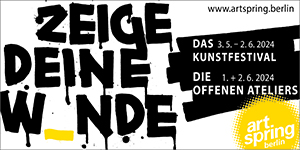by Aoife Donnellan // Apr. 25, 2024
‘Romantic Ireland’—the Irish pavilion at this year’s Venice Biennale, by visual artist Eimear Walshe—explores the history of land contestation in Ireland and intergenerational care, both materially and thematically, through video, installation and a five-voice opera. Curated by Sara Greavu and Project Arts Centre, the work takes ‘On Language & the Irish Nation,’ a radio broadcast by Éamon De Valera—Irish revolutionary, Taoiseach (Prime Minister) from 1957-1959 and president from 1959-1973—as its foundational text. This speech, often referred to as ‘The Ireland that we dreamed of,’ celebrated the 50th anniversary of the foundation of Conradh na Gaeilge, an organisation dedicated to promoting the Irish language and culture, and outlined De Valera’s vision for an ideal Irish Republic.
The video element of ‘Romantic Ireland’ features seven performers including Walshe, led by choreographer Mufutau Yusuf. They wear green latex face-coverings, dancing, wrestling and filming one another in a semi-completed earth structure, accompanied by a libretto describing the eviction of an elderly man in his dying hours. This meitheal—a group who come together in a cooperative labour practice—investigates care, class and history through collective gestures, filming one another to create a collage of perspectives. The narrative of the video work follows land contestation in Ireland, from the 19th century up to the ongoing housing crisis. The piece is delicate and fierce, calling on a rich history of technique and tradition. Walshe’s work finds strength in collaboration, drawing on skills from a range of disciplines to create a work that literally, and figuratively, sings. We spoke about material histories, the power of absenting language and working conditions in the arts.
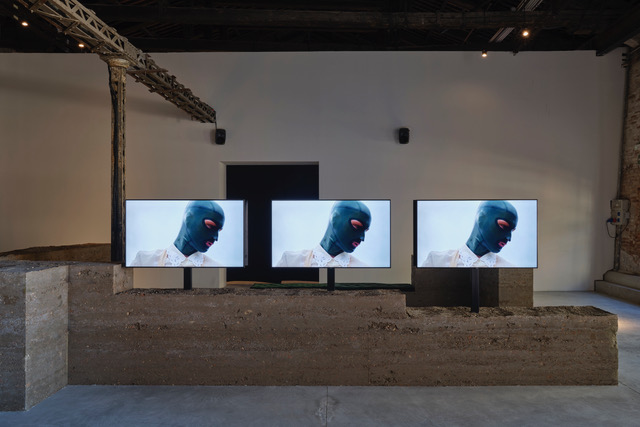
Eimear Walshe: ‘ROMANTIC IRELAND,’ installation view, Irish Pavilion, Venice Biennale 2024 // Photo by Simon Mills
Aoife Donnellan: Your work approaches history and politics from an embodied, personal and local perspective. How do you go about narrativising history for your work? Does it relate to the aesthetics of your work?
Eimear Walshe: This is one of my primary tasks to figure out whenever I’m making work. In this project, ‘Romantic Ireland,’ I try to approach that question, which is one I think about all the time, in three different ways. Two of them are more of a challenge to my automatic or conventional approach. The first part of making this work was working with Amanda Feery on the opera. Amanda approached me with the idea of writing a libretto linked to the Éamon De Valera speech. It’s a very interesting moment in history and a very fascinating text. It’s a text that people don’t like in Ireland, for a few reasons, but it mostly centred around the social conservatism that he promoted or admired in the Irish. He makes the claim that this is what we were fighting for, which is not true. The revolutionaries, their manifesto or their proclamation, was for an anti-imperialist, fiscally progressive, socially progressive Republic. By the 1940s, it’s absolutely clear that is not what’s been achieved from the revolution.
In that speech, there’s a covering up of a betrayal of the goals. At the same time, there’s something that I can’t help but feel very moved by or attached to in the speech. There is this remaining aspirational, still completely fantastical, framing of a desire for an Ireland where there is enough for everyone, people are housed, people have happy lives and the elderly are respected. These are some of the quotes that appear in a distorted form in the libretto; “the laughter of happy maidens, the romping of sturdy children, the contest of athletic youths and the countryside dotted with bright and cosy homesteads,” and the elderly being looked after, I find that very compelling. The conditions on which it’s offered, the deal that’s trying to be cut in this piece of political rhetoric, is that these things can be ours, once we live how God intends us to. And what’s heartbreaking about looking back at that speech is that the Irish people kept up their side of the bargain; we were pious, we were credulous, we were compliant, and still the fiscal progressive promises of this era never got delivered.
That betrayal of history or that straightforward hypocrisy is what I wanted to address in the libretto. It’s a fictional narrative of a man who’s trying to spend the last hours of his life inside his home, being evicted by a gang of young men, who are also there to break apart his house. That theme of demolishing evictions—to put a tenant out and then to break apart the property that you own in order to make it unusable by them—is a real through-line that runs from a part of history that I’m really interested in, the late and mid 19th century, to today. I think the perversity of that is something that I felt was a reflection of that betrayal or that hypocrisy, contrasting that vision of the De Valera speech with the lives that were being lived and the poverty of the 1940s.
An interesting thing about that speech that Lisa Godson [Irish academic in design history and material culture] told me about was that it was broadcast at night in Ireland, so that it would have an evening broadcast in America. It’s really about representing Ireland abroad, creating a fantasy.
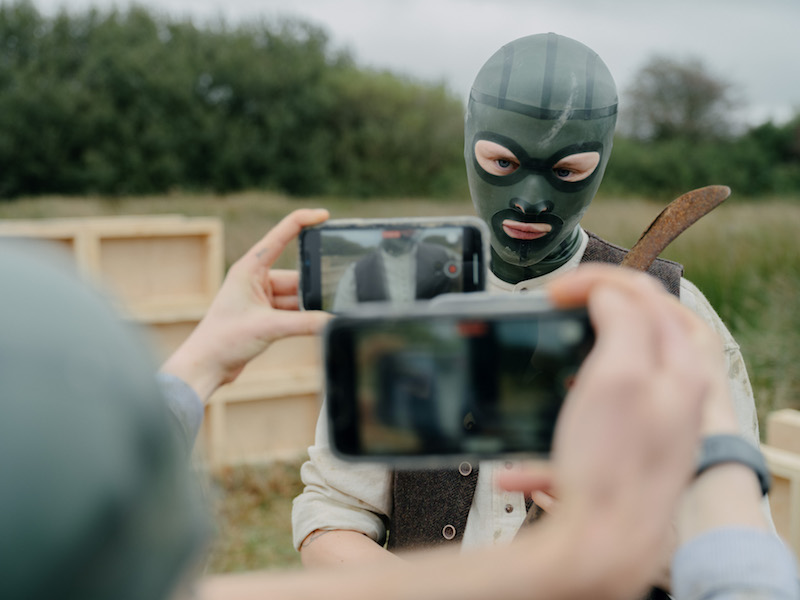
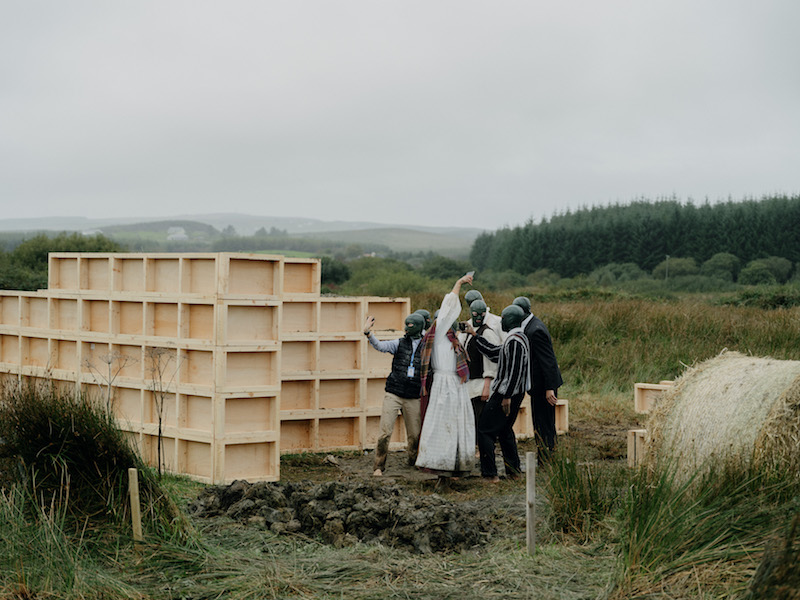
Eimear Walshe: ‘ROMANTIC IRELAND,’ photographed 2023, production still // Photo © Faolán Carey, courtesy Eimear Walshe and Ireland at Venice
AD: ‘Romantic Ireland’ features installation, video, costume, opera, choreography and labour practices, among other media. How did you choose the media for the piece?
EW: I’m very comfortable working through text, it’s probably my primary format. What I wanted to do to challenge myself was in the video, the characters don’t speak. I wanted to work through gesture because I need the practice of absenting language, it feels really important. The absolute best way to do that—I’m so lucky to have been able to—is to work with dancers, whose fluency is through gesture and movement. Mufutau Yusuf came on board around this time last year, and we started developing an improvisational choreography concept that was not to do with dancing, but more to do with the movements and gestures that are built into this type of building. Which in its own way is linked to dancing, because mixing the materials for earth-building is like making wine; you’re dancing, and you’re compressing, and you do it collectively. So we came to dance from around the corner of a labour practice.
In the video, the address of history came through the costuming. I worked with Amie Egan to develop the costumes. The concept for them was that from the neck down, they’d represent archetypical characters from Ireland from the 19th to the 21st century. They’d all be crammed together in one space-time. From the neck up, they’d all have this universalizing olive green latex mask that has associations with sexual deviancy, but also criminality and militarism. For me, one of the concerns is how part of the colonial toolkit is the construction of colonised people as terrorists whenever they wish to resist their colonisation.
Finally, in the sculpture, every time I make this work, I’ll use an earth-building practice that locals have because earth-building is all about local materials and local knowledge. In Venice, I found this amazing building team called Rebiennale, who had rammed earth as an earth-building style that they had the knowledge of and the materials for locally. The local version in Ireland is Cob, there’s loads of iterations all around the world, like Adobe or rammed earth, all sorts of different techniques, different compositions of clay, sand, sometimes straw, and all built for different climates. Inside that material, you get the history of people becoming settled from nomadism. Some of the oldest surviving earth buildings are in Tel al-Sultan in Palestine, Wadi Feynan in Jordan and the eastern Mediterranean, this area where people are on the cusp between nomadism and agriculture, and people gathered to build collectively. It takes an extraordinary amount of labour, water, time and materials to make structures like this. I am fascinated by the collective dedication of time to that.
That material links back to aesthetics and to both the video and the opera. What’s so fascinating to me with opera is that it smudges words, it extends them. You can have a whole 20-minute section that’s just, “amen,” over and over again.
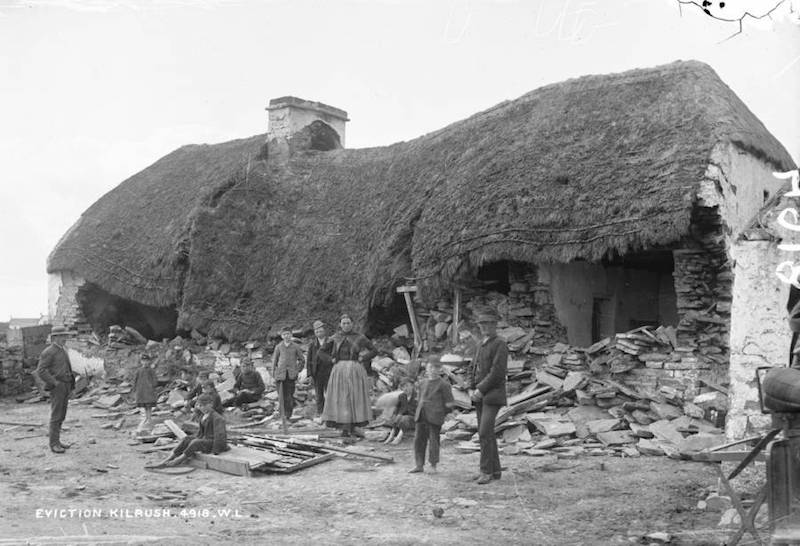
Kilrush, County Clare, Robert French, A family in the 1880s who’ve been evicted and their house pulled down, a common practice at this time // Courtesy of the artist
AD: The costuming, materials, sound and text in the work all seem to play with time.
EW: Yeah, and it also plays with the intelligibility of language. Writing a libretto is very different than writing a poem or prose because the way the words exist in the singer’s mouth is not the same as speech whatsoever. With the video, I had read this essay by Joseph Noonan-Ganley about “the muddy image.” We shot the video on phones and we passed the phones between us. The whole concept was shooting on phones so that everyone is the director, everyone is the Director of Photography, and everyone is the performer. You get this decentralising of the gaze. That felt very linked between the extending or smudging or making illegible or unintelligible, in the same way that opera does to speech. That’s linked to the performers’ masks. The obstruction of full speech intelligibility is extremely interesting and beautiful to me.
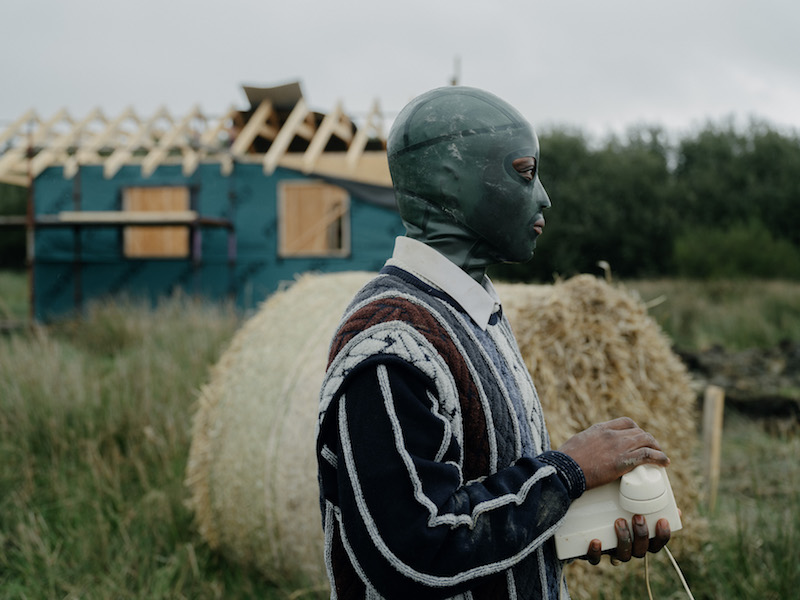
Eimear Walshe: ‘ROMANTIC IRELAND,’ photographed 2023, production still // Photo © Faolán Carey, courtesy Eimear Walshe and Ireland at Venice
AD: Your practice seems rooted in collaboration, both between people and media, with this work including an immersive sculpture, a video installation and an opera. How do you traverse the limits and boundaries of your practice with other people?
EW: Whether it’s a critical community, or direct collaboration, like making something together, the people that you’re in conversation with or that you’re working with extend the scope and ambition of your work. They create an artistic range that you don’t have by yourself. I’m very conscious of that when I’m working, and I’m also really conscious that artists work together all the time, but we don’t think about how we’re working together enough. We set up each other’s working conditions in a way that’s under-discussed. It’s something that I really wanted to work on through this project. One of the tough jobs in this project was the job of the performers. We had no shoes on in October and had these masks that are moderately challenging to work in. I wasn’t originally going to perform in the work, and at a certain point, I realised that I had to perform in the work because I needed to be in real-time realising what people were needing to give to be able to produce these images. I think as a director you can get too image-focused, and you’re not thinking about what it’s taking for people to produce them.
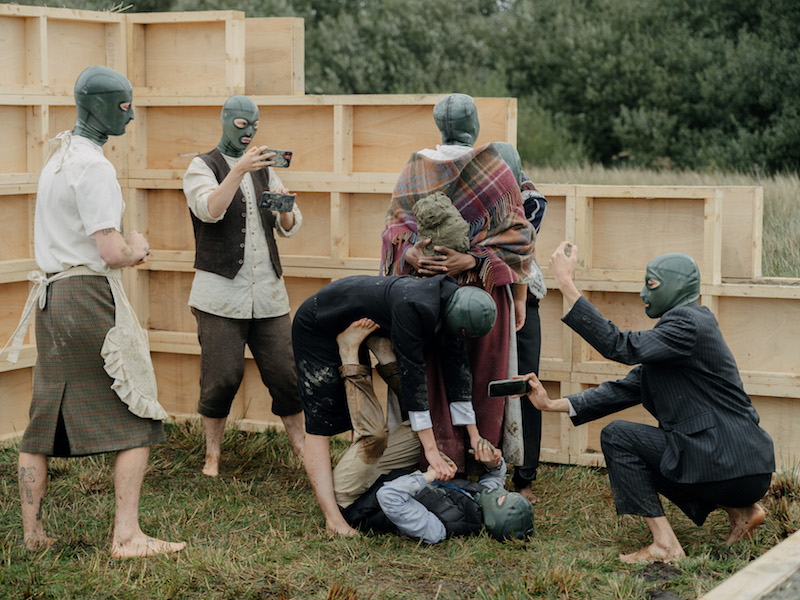
Eimear Walshe: ‘ROMANTIC IRELAND,’ photographed 2023, production still // Photo © Faolán Carey, courtesy Eimear Walshe and Ireland at Venice
AD: It sounds like you lead your projects with care, which comes through in the work. Is that important to your practice?
EW: I think there are so many projects where the concept and the practices don’t match. You can’t make an artwork about how we used to work in mutual aid together and communities and then treat people like shit. I think that’s way too prevalent, I suppose because people are fixated on outcomes, and there is anxiety that you can bring to the table that supersedes relationships, and is very short-term thinking. There’s a lack of skills. You have to be humble, there are always opportunities to skill-up on this. I wish that it was more prevalent because most of my gigs are in collaboration with others. How those things go and how we treat each other sets the tone of our whole working lives. You don’t want to be a bad boss yourself, and you don’t want to be a boss for others. I think artists are so used to self-exploitation, that they normalise it and expect others to do the same. I think it’s really important to resist that.
Exhibition Info
Irish Pavilion
Eimear Walshe: ‘Romantic Ireland’
Exhibition: Apr. 20–Nov. 24, 2024
irelandatvenice2024.ie
Irish Pavilion, Artiglierie Arsenale, Venice, click here for map



